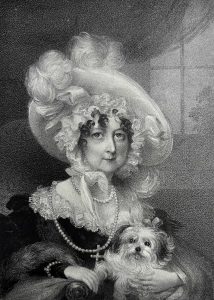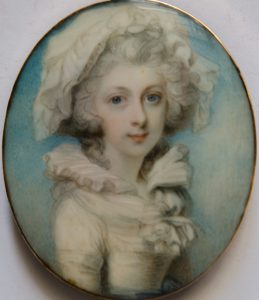Politics, scandal and a friend to Royalty: Who was Mary Marchioness of Downshire and Baroness Sandys?
- 18th February 2025
Mary Marchioness of Downshire and Baroness Sandys (1764-1836) was the middle child of Colonel Martin Sandys (1729-1768) and Mary Trumbull (1741-1769). Known as ‘the Little Marchioness’, she grew up as part of the extended royal circle – her father being an Equerry to the King’s uncle – yet her childhood was one of tragedy. An orphan aged five, she quickly became an only child when her brothers William and Edwin too died young.
These deaths meant Mary inherited through her mother’s line the extensive estates of the Trumbull and Blundell families, and, as the last surviving grandchild of Samuel 1st Baron, the Sandys and Russell estates from her childless uncle Edwin after his death in 1797. Through her marriage to Arthur Hill in 1786, she also became on his father’s death, Marchioness of Downshire in 1793. When widowed in 1801, her connections proved useful, and she was created Baroness Sandys in her own right. All this made Mary one of the foremost heiresses of her day. Yet she was more than just the wife of a Marquis and popular London regency hostess.

The Marchioness of Downshire Baroness Sandys, painting by Mrs Mee _ M. Gauci lithograph – Reference: BA16936
When Mary’s mother died, and with her maternal grandparents predeceased, she and her brothers passed into the care of their great aunt, Mary Bertie – an ‘affectionate parent’ whose second husband was Lord of the Bedchamber to George III. Lady Bertie had three residences, in Kent, London and Roehampton and it was to this latter home in the Surrey countryside that Mary was most attached. It was also from the London house in Hanover Square that Mary went to the nearby church of St Marylebone to marry Arthur. The happy couple were fifth cousins, and by all accounts a golden couple. Letters written by Arthur held in the Sandys Archive demonstrate an affectionate bond between them.

The Little Marchioness, then Viscountess Fairford by Richard Cosway, c.1786, miniature watercolour on ivory in gold frame © Trustees of the Ombersley Conservation Trust
However, Arthur was an erratic, absent husband, prone to debt and described by one political opponent as a ‘whoremaster, a pimp and an adulterer’. As an MP in the Dublin parliament, he stood in opposition to a united Ireland and lived in fear he would be assassinated when there. Indeed, in 1796, he was uncovered as the target for a Belfast murder plot. When Arthur died (shortly before the birth of their seventh child) Mary fought fiercely to salvage what had become his tarnished reputation. This, despite learning upon the reading of his will that Arthur had fathered three children prior to their marriage, and later that he’d taken a lover during his military studies in France.
Arthur’s death saw the emergence of Mary as head of the family. A capable widow, she took charge of the family’s business affairs and secured for herself an English peerage that involved the direct efforts of the then prime minister. This peerage restored the Sandys title that had lapsed five years prior on uncle Edwin’s death.
Throughout her life, Mary paid attention to the business of parliament – advice we know she gave her children whom she encouraged to examine, on both sides, political questions as impartially as possible. ‘Consider the politicks of the present day’ she wrote ‘make it your study to become acquainted with the different administrations that have existed…It is desirable that you shod be acquainted with the history of your Country […] but no period is more worthy that that of…the period which gave rise to the Whigs and Tories’.
True to the British Whig party, Mary wrote often to her friend Sir Phillip Francis with political news and scandal, including during a period leading up to the defeat of Napoleon Bonaparte, their opinions on whom are spirited to say the least. According to the will of Mary’s grandson Arthur Blundell George Sandys Hill, Captain Edmund Palmer wrote to her in 1814 enclosing an ‘oak circular box made from the wood of the Victory enclosing some of Lord Nelson’s hair’, which she kept in a blue Moroccan case with two small crowns on top. Edmund was the brother of Mary’s Aid de Camp and the Whig MP for Bath, Colonel Charles Palmer.
Another of Mary’s principal correspondents was her ‘devoted tho’ gossiping’ friend Lady Elizabeth Vaughan. As well as Benjamin Bloomfield – private secretary to George IV – with whom her late night calls fuelled the rumour they were lovers despite his marriage. Alas there are no letters between these two in the archive. In 1807, Mary hosted royalty at Ombersley Court, entertaining the Prince of Wales and his brother the Duke of Sussex during their tour of the midland counties. When living in Hanover Square, the Duke was a regular visitor of Mary’s though there is no evidence to suggest they were anything more than friends. A rich widow, Mary was known to have declined offers of a second marriage, including from another royal duke which, had she accepted, would have seen her become Queen Consort.
Yet despite Mary’s great fortune (much of which she spent on remodelling Ombersley Court) her privileged life was also one of immense sadness. A survivor, she was orphaned early on and lived to mourn the premature deaths of a son and both her daughters. She was by all accounts a formidable personality, and her story is a fascinating one.
Worcestershire Archive hold the Sandys family archive. Currently being catalogued, you can keep up with the project’s progress on our project page, here: Ombersley Conservation Trust Sandys Archive – Worcestershire Archive & Archaeology Service
If you would like to access any of the records mentioned in this blog, please submit an enquiry at ArchiveEnquiry (worcestershire.gov.uk) or speak to a member of archive staff on Level 2 of The Hive
Post a Comment